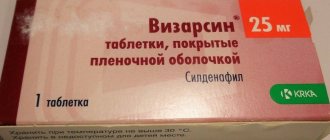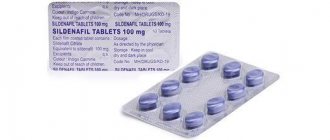Instructions for use of VIAGRA
Effect of other drugs on sildenafil
In vitro studies
Sildenafil is metabolized primarily by the cytochrome P450 (CYP) isoenzyme 3A4 (main pathway) and 2C9 (additional pathway), therefore inhibitors of these isoenzymes may reduce the clearance of sildenafil, and inducers of these isoenzymes may increase the clearance of sildenafil.
In vivo studies
Population pharmacokinetic analysis of clinical trial data demonstrated a decrease in the clearance of sildenafil with concomitant use of CYP3A4 inhibitors (such as ketoconazole, erythromycin, cimetidine
). Despite the fact that with simultaneous use of sildenafil and CYP3A4 inhibitors there was no increase in the incidence of adverse events, the use of the drug at an initial dose of 25 mg should be considered.
Concomitant use of sildenafil (at a dose of 100 mg once) and ritonavir
(500 mg 2 times / day), an HIV protease inhibitor and a strong inhibitor of cytochrome P450, against the background of achieving a constant concentration of ritonavir in the blood, led to an increase in sildenafil Cmax by 300% (4 times) and AUC by 1000% (11 times ). After 24 hours, the plasma concentration of sildenafil remained at 200 ng/ml compared to 5 ng/ml after a single dose of sildenafil alone. This is consistent with the pronounced effect of ritonavir on a number of drugs that are substrates of cytochrome P450. Sildenafil had no effect on the pharmacokinetics of ritonavir. Based on the results of pharmacokinetic studies, the combined use of sildenafil and ritonavir is not recommended (see section Special instructions) and under no circumstances should the maximum dose of sildenafil exceed 25 mg within 48 hours.
With the simultaneous use of sildenafil (at a dose of 100 mg once) and saquinavir
(at a dose of 1200 mg 3 times / day), an HIV protease inhibitor and an inhibitor of the CYP3A4 isoenzyme, while achieving a constant concentration of saquinavir in the blood, Cmax of sildenafil in the blood increased by 140%, and AUC increased by 210%. Sildenafil had no effect on the pharmacokinetics of saquinavir (see Dosage Regimen). Stronger CYP3A4 inhibitors, such as ketoconazole and itraconazole, may cause more pronounced changes.
Single dose of sildenafil 100 mg together with erythromycin
(500 mg 2 times a day for 5 days), a moderate inhibitor of the CYP3A4 isoenzyme, while achieving a constant concentration of erythromycin in the blood, led to an increase in the AUC of sildenafil by 182%. Administration of azithromycin (500 mg per day for 3 days) to healthy male volunteers had no effect on the AUC, Cmax, Tmax, elimination rate constant and half-life of sildenafil or its main circulating metabolite.
Cimetidine
(at a dose of 800 mg), an inhibitor of cytochrome P450 and a nonspecific inhibitor of CYP3A4, when taken together with sildenafil (at a dose of 50 mg) led to an increase in the concentration of sildenafil in the blood plasma of healthy volunteers by 56%.
Grapefruit juice
is a weak inhibitor of CYP3A4 metabolism in the intestinal wall and may cause moderate plasma levels of sildenafil.
One-time dose of antacid
(magnesium hydroxide/aluminum hydroxide) did not affect the bioavailability of sildenafil.
Despite the fact that specific studies of the interaction of sildenafil with all drugs have not been conducted, according to population pharmacokinetic analysis, the pharmacokinetics of sildenafil did not change when used simultaneously with drugs belonging to the group of CYP2C9 inhibitors (such as tolbutamide, warfarin, phenytoin
), a group of CYP2D6 inhibitors (such as
selective serotonin reuptake inhibitors, tricyclic antidepressants
), a group of
thiazide and thiazide-like diuretics, loop and potassium-sparing diuretics, angiotensin-converting enzyme inhibitors, calcium channel blockers, β-adrenergic antagonists
or inducers of CYP450 metabolism (such as
rifampicin, barbiturates
).
In a study of healthy male volunteers, co-administration of the endothelin antagonist bosentan
(which is an inducer of CYP3A4 [moderate], CYP2C9 and possibly CYP2C19) at steady state (125 mg twice daily) and sildenafil at steady state (80 mg twice daily) times daily) led to a decrease in AUC and Cmax of sildenafil by 62.6% and 55.4%, respectively.
Concomitant use of strong CYP3A4 inducers, such as rifampicin
, can be expected to cause a more pronounced decrease in sildenafil plasma concentrations.
Nikorandil
It has the properties of a potassium channel activator and a nitrate-like effect. Due to the nitrate component, this drug has the potential to interact with sildenafil in a clinically significant manner.
Effect of sildenafil on other drugs
In vitro studies
Sildenafil is a weak inhibitor of isoenzymes 1A2, 2C9, 2C19, 2D6, 2E1 and 3A4 (IC50 >150 µM) of cytochrome P450. When taking sildenafil in recommended doses, its Cmax is about 1 µmol, so it is unlikely that Viagra can affect the clearance of substrates of these isoenzymes.
Information on the interaction of sildenafil and nonspecific phosphodiesterase inhibitors such as theophylline and dipyridamole
, are missing.
In vivo studies
Consistent with the known effect on the NO/cGMP signaling cascade (see section Pharmacological action), sildenafil has been demonstrated to potentiate the hypotensive effect of nitrates, and therefore, the use of nitric oxide donors or nitrates
in any form together with sildenafil is contraindicated (see section Contraindications).
Riociguat
: Preclinical studies have shown an additive systemic blood pressure lowering effect with concomitant use of PDE5 inhibitors and riociguat. In clinical studies, riociguat has been shown to enhance the hypotensive effect of PDE5 inhibitors. There is no evidence of a beneficial clinical effect of this combination in population studies. The simultaneous use of riociguat and PDE5 inhibitors, including sildenafil, is contraindicated (see section Contraindications).
Combined use of sildenafil and an α-blocker
may lead to the development of symptomatic hypotension in certain predisposed patients.
The development of this condition can most likely be observed within 4 hours after taking a dose of sildenafil (see sections Dosage regimen and Special instructions). In three drug-drug interaction studies, patients with benign prostatic hyperplasia (BPH) stable on doxazosin
were co-administered the α-blocker doxazosin (4 mg and 8 mg) and sildenafil (25, 50 and 100 mg). mg). Patients included in these studies had a mean additional reduction in supine blood pressure of 7/7 mmHg. Art., 9/5 mm Hg. Art. and 8/4 mm Hg. Art. and an average decrease in blood pressure in a standing position of 6/6 mmHg. Art., 11/4 mm Hg. Art. and 4/5 mm Hg. Art. respectively. When sildenafil and doxazosin were used concomitantly in patients stable on doxazosin, reports of symptomatic orthostatic hypotension were infrequent. These reports included cases of dizziness and lightheadedness without syncope.
Signs of significant interaction of sildenafil (at a dose of 50 mg) with tolbutamide
(at a dose of 250 mg) or
warfarin
(at a dose of 40 mg) - drugs that are metabolized by CYP2C9 have not been identified.
Sildenafil (at a dose of 50 mg) did not potentiate the increase in bleeding time caused by acetylsalicylic acid
(at a dose of 150 mg).
Sildenafil (at a dose of 50 mg) did not potentiate the hypotensive effect of alcohol
in healthy volunteers with a maximum ethanol level in the blood of an average of 80 mg/dl.
In patients treated with sildenafil, there were no differences in the safety profile compared to placebo with simultaneous use of such classes of antihypertensive drugs as diuretics, beta-adrenergic blockers, ACE inhibitors, angiotensin II receptor antagonists, antihypertensive drugs (vasodilators and centrally acting drugs) , adrenergic blockers, calcium channel blockers and α-adrenergic blockers
.
In a special clinical study aimed at studying drug interactions, with the combined use of sildenafil (100 mg) and amlodipine
in patients with arterial hypertension, an additional decrease in systolic blood pressure in the supine position of 8 mm Hg was noted. Art. The corresponding decrease in diastolic blood pressure was 7 mmHg. Art. The magnitude of these additional reductions in blood pressure were comparable to those observed in a group of healthy volunteers when using sildenafil alone (see section Pharmacological action).
Sildenafil (at a dose of 100 mg) had no effect on the pharmacokinetics of HIV protease inhibitors, saquinavir
and ritonavir, which are substrates of the CYP3A4 isoenzyme, in an equilibrium state.
Sildenafil at steady state (80 mg three times daily) caused an increase in bosentan
(125 mg twice daily) by 49.8% and Cmax by 42% in healthy male volunteers.
Not born with bastard
There are a lot of people who want to make money in the new reality, where male consumers are ready to spend huge amounts of money on solving problems with potency. Following Viagra, a stream of cheap alternatives, imitations and simply crude counterfeits poured onto the market, promising to restore lost male power. If Pfizer's product is a prescription drug, the side effects of which are described in detail, then manufacturers of analogues tried to deliver their product directly to those suffering, avoiding medical and legislative restrictions - in other words, selling without a prescription. An excellent way out for this was the release of potency products in the form of biologically active additives (dietary supplements). In the 2000s, this market in Russia grew by leaps and bounds. According to the industry agency DSM Group, in 2008 sales of dietary supplements in monetary terms increased by a third.
An active seller of potency enhancing products in Russia was the advertising and information agency (RIA) “Panda”. The company was founded in 1996 by military historian Igor Voroby in St. Petersburg and initially had nothing to do with pharmaceuticals. But by the mid-2010s, Panda became an industry leader and firmly occupied second place among Russian manufacturers of all dietary supplements. And although the company’s portfolio included hundreds of items, it was the drugs for improving potency Sealex and Alicaps, positioned as dietary supplements, that provided more than 40 percent of revenue
It is almost impossible to sell dietary supplements without a powerful advertising campaign: doctors do not prescribe supplements because, by law, they do not have the right to do so. Therefore, advertising, primarily on television, is the main marketing tool when promoting dietary supplements. Manufacturers of dietary supplements did not skimp, and not a single broadcast of a football or hockey match on television until mid-2010 was complete without perky and memorable advertising of potency pills. The singer Sergei Shnurov became the face of Alicaps. An advertisement for a dietary supplement with the leader of the Leningrad group in the role of a “brutal male” was shown on television dozens of times a day. For selling himself as an alpha male, Shnurov received 150-200 thousand dollars.
In parallel with Alicaps, RIA Panda promoted Sealex. The advertising campaign for this drug was built around an elderly male walker who travels the world, running to have sex with beauties from another country, humiliating their real husbands: “Sealex?! This Russian was here!” - the injured anti-heroes scream in powerless rage. “The male advertising audience during the national team’s performance at the 2014 FIFA World Cup was at least seven million people,” said Dmitry Dergachev, president of RIA Panda. The video hit the target audience like a bull's eye.

